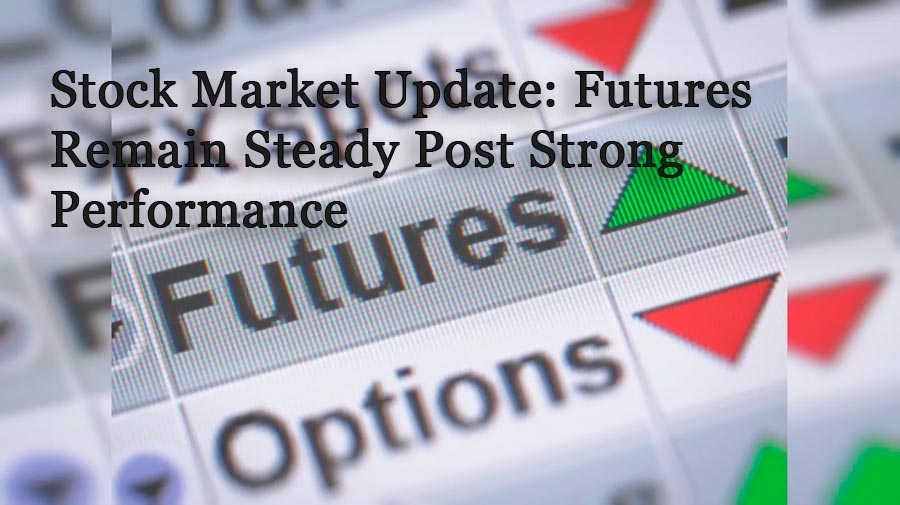July 14, 2024 This Week Top S&P 500 Gainers & Losers
Tesla: Time To Take Profits
Microsoft: The Q4 Results Should Surprise You
Tesla: Optimus And FSD Probably Won’t Save The Day
April 23, 2024 Maximizing Profits: When is the Right Time to Sell Your Business?
April 12, 2024 Improve Your Financial Status: A How-To Guide
April 12, 2024 How ZIM Integrated Container Tracking is Revolutionizing Global Trade
March 15, 2024 6 Best Growth Stocks To Buy Now According to Metatrader 5
Stock Market Update: Futures Remain Steady Post Strong Performance
May 17, 2024

Are you curious about the recent stock market performance? The U.S. futures stayed steady following a strong showing in yesterday’s trading session. We will provide an update on the current state of the stock market and offer insights into what factors are driving this stability. Stay tuned to learn more!
Key Takeaways
- The Dow Jones Industrial Average crossed $40,000, showing strong market confidence.
- U.S. futures stayed steady with slight changes: Dow Jones futures dropped by 0.04%, Nasdaq 100 rose by 0.08%, and S&P 500 increased slightly by 0.01%.
- Tech companies drove the Nasdaq 100 up by 2.2%, while broad market gains pushed the S&P 500 up by 1.4%.
- Investors hope for lower interest rates in 2024, which is causing more people to invest in stocks.
- Walmart’s stock went up by 7% after beating Q1 expectations, boosting investor confidence across markets.
U. S. Market Update
Dow Jones reaches a new high, while futures remain steady. Nasdaq 100 and S&P 500 performance in focus.
Dow Jones Hits New High
The Dow Jones Industrial Average crossed the $40,000 mark for the first time. This major milestone shows strong market performance. Investors saw it rise 0.9% this week alone, signaling positive momentum in equity markets.
This jump to new heights reflects investor confidence and a bullish outlook on financial markets. The Dow’s success pulls attention to strengths in investments and equities, underscoring a robust economy behind these numbers.
Futures Remain Steady
U.S. futures stayed the same early Friday morning, showing little change after a strong market performance. Dow Jones futures slipped slightly, losing about 0.04% at 2:11 a.m. EST on May 17.
Meanwhile, Nasdaq 100 (NDX) futures saw a small increase of 0.08%, and S&P 500 (SPX) futures barely moved, going up by just 0.01%. This shows that investors are cautiously waiting for their next move.
Market makers keep watching premarket trading closely to guess what might happen during open market hours.
Investors kept an eye on several factors including corporate earnings and economic reports which could influence the direction of stocks in the coming days. Futures acting steady suggests that there is balance between buyers and sellers in the market, keeping prices stable for now.
Nasdaq 100 and S&P 500 Performance
With the stability in futures, attention now shifts to the performance of major indices – the Nasdaq 100 and the S&P 500. These two have shown remarkable trends over the past week, reflecting investor sentiment and broader economic signals.
Here’s a closer look at their performance in a simple table:
| Index | Performance This Week | Notable Movement |
|---|---|---|
| Nasdaq 100 | Up 2.2% | Strong tech earnings |
| S&P 500 | Up 1.4% | Broad market gains |
Tech companies lifted the Nasdaq 100, showing the sector’s resilience and growth potential. Meanwhile, the S&P 500, a mix of industries, climbed thanks to widespread gains across sectors. This suggests confidence in the market’s overall health and future prospects. Each index tells a story of recovery, optimism, and the complex interplay of factors driving the stock market today. Investors watch these indicators closely, using them to guide decisions and strategies.
Factors Contributing to Market Performance
Optimism about interest rate cuts, strong corporate earnings, a key economic report release, and the impact of individual company performance are crucial factors shaping market performance.
Market sentiment is influenced by various elements such as interest rate changes, profit growth within companies, critical economic indicators, and contributions from specific corporations.
Optimism about Interest Rate Cuts
Investors are looking forward to possible lower interest rates in 2024. This hope makes people want to invest more in the stock market. The Federal Reserve might cut rates, helping businesses and individuals save money on loans.
When loans are cheaper, companies can grow and people spend more. This good news pushed up the Dow Jones, Nasdaq Composite, and S&P 500 futures.
Lower interest rates usually mean stocks do better. Investors watch the Federal Reserve’s decisions closely because they affect how much it costs to borrow money. With signs pointing to cuts, many feel positive about where the market is headed next.
This mood leads into discussions on strong company earnings and their impact on stocks.
Strong Corporate Earnings
Transitioning from the optimism about interest rate cuts to strong corporate earnings, investors are witnessing a surge in stock values driven by robust company performance. As companies continue to report impressive financial results, the stock market is being buoyed by this influx of positive news.
With Walmart marking a significant 7% rise after surpassing Q1 expectations, it exemplifies the impact of strong corporate earnings on market sentiment. The combination of successful companies like Doximity and Walmart underpins this growing confidence in the market.
“Strong corporate earnings not only boost investor confidence but also serve as a testament to the resilience and adaptability of businesses in navigating through ever-changing economic landscapes.”
Key Economic Report Release
Following the upbeat news on corporate earnings, investors eagerly wait for the release of the U.S. Conference Board Leading Economic Index. The report due today is expected to shed light on key economic indicators, potentially influencing market sentiment and investment strategies as it provides valuable insights into future economic activity.
Investors keep a close eye on this important report as it could impact their decision-making process, guiding their next moves in the everchanging world of investing.
Impact of Individual Company Performance (Walmart and Doximity)
After a robust analysis of the Key Economic Report Release, it is evident that individual company performances notably influenced the market dynamics. Notably, Walmart’s quarterly outcomes surpassed predictions, heightening investor confidence and affirming its consistent growth trajectory.
- Walmart (WMT) experienced a remarkable 7% upsurge as its Q1 results exceeded expectations, reflecting its resilient business model and adaptability to evolving market demands.
- This positive turn not only secured investor confidence but also contributed to the overall buoyancy of the market sentiment concerning retail entities.
- Doximity (DOCS) noted an impressive after-hours trading upturn of approximately 16%, propelled by better-than-anticipated Q4 results and a strategic stock buyback initiative.
- The stock’s upward trajectory underscores the company’s pivotal role in the ever-evolving healthcare technology sector, solidifying its position as a promising investment option for discerning investors seeking sustainable returns.
Global Market Update
- U.S. Treasury yields fluctuate, impacting global markets.
- European and Asia-Pacific indices react to evolving market conditions.
U.S. Treasury Yield and Crude Oil Futures
In the intricate dance of the financial markets, two major players often capture the attention of investors: the yield on U.S. treasuries and the price of crude oil. These indicators serve as the pulse of economic health and investor sentiment, guiding decisions and strategies in the complex world of investing.
| Indicator | Details | Impact on Markets |
|---|---|---|
| U.S. 10-Year Treasury Yield | Down, near 4.38% | A lower yield suggests investors are moving towards safety, often indicating concerns about economic growth or seeking shelter during uncertain times. |
| WTI Crude Oil Futures | Trending higher, near $79.39 per barrel | An increase in oil prices can signal economic recovery or growth, affecting inflation and consumer spending, thus influencing stock market performance. |
Yields on U.S. treasuries, particularly the 10-year note, are a benchmark for investor confidence. A dip in these yields, as observed, reflects a cautious or bearish outlook among investors, prompting a shift towards bonds as a safe harbor. This dynamic often has a domino effect across various sectors, subtly shaping market trajectories.
Conversely, the uptick in crude oil prices presents a different narrative. Rising oil prices, indicative of higher demand or lower supply, hint at economic expansion. Yet, this surge comes with its own set of challenges, sparking fears of inflation. For investors, this becomes a delicate balancing act, weighing the boon of growth against the bane of inflationary pressures.
These indicators do not exist in isolation but are intertwined with global economic events, corporate earnings reports, and geopolitical tensions. For instance, an upbeat earnings season or positive economic data might offset concerns around rising oil prices, while escalating tensions in oil-rich regions could exacerbate them.
Investors, therefore, find themselves at the helm of a ship navigating through the fog of market signals. The yield on U.S. treasuries and the futures of crude oil serve as lighthouses, offering guidance but also reminding of the inherent uncertainties that lie ahead.
In sum, while both indicators — the treasury yield and oil prices — offer valuable insights, they also underscore the complexities of market dynamics. Astute investors will keep a keen eye on these trends, incorporating them into a broader strategy aimed at balancing risk and reward in the ever-shifting landscape of the stock market.
European and Asia-Pacific Indices Performance
European and Asia-Pacific markets showed a mixed performance today. Below is a detailed tabular representation of how various indices across these regions fared:
| Region | Index | Performance |
|---|---|---|
| Asia-Pacific | Shanghai Composite (China) | Up 0.22% |
| Asia-Pacific | Shenzhen Component (China) | Up 0.28% |
| Asia-Pacific | Hang Seng (Hong Kong) | Up 0.65% |
| Asia-Pacific | Nikkei (Japan) | Down 0.56% |
| Asia-Pacific | Topix (Japan) | Up 0.1% |
China’s markets saw a slight increase, with both the Shanghai Composite and the Shenzhen Component indices ending the day in positive territory. This rise follows a set of encouraging economic reports from China, revealing a surge in industrial production and a drop in unemployment rates. However, China’s retail sales and fixed asset investment grew at a slower pace than many had hoped.
Hong Kong’s Hang Seng index also saw gains, increasing by 0.65%. This upwards movement reflects investor confidence in the region, despite mixed signals from other global markets.
Conversely, Japan’s Nikkei index took a hit, dropping by 0.56%. Despite this, the Topix index, another key Japanese market indicator, managed a small rise of 0.1%, showing that investors remain cautiously optimistic about Japan’s economic outlook.
Overall, the performance of European and Asia-Pacific indices underscores the complex interplay of global economic trends, investor sentiment, and regional developments. As investors keep a close eye on these markets, the forthcoming Eurozone Consumer Price Index data will no doubt play a crucial role in shaping future market movements.
Conclusion
In summary, U.S. futures stood steady following a robust market performance, notably with the Dow Jones hitting a new high. The positive trend is attributed to optimism about potential interest rate cuts and strong corporate earnings, including Walmart’s impressive Q1 results and Doximity’s stock buyback program.
While U.S. Treasury yield decreased, WTI crude oil futures trended higher. European and Asia-Pacific indices displayed mixed performance as investors closely monitored economic data releases.
This promising market update marks an encouraging outlook for investors navigating the ever-changing realm of global markets. With factors such as interest rates, corporate performances, and geopolitical developments continuing to underpin financial landscapes, staying abreast of these complexities remains crucial for tailored investment strategies in this ever-evolving world of finance.















